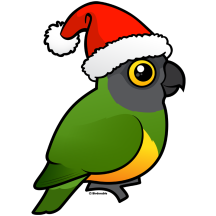The Senegal Parrot is a resident breeder across a wide range of west Africa. It migrates within west Africa, according to the availability of the fruit, seeds and blossoms which make up its diet. It is considered a farm pest, often feeding on maize or millet.
Senegal Parrots are birds of open woodland and savanna. It is a gregarious species, continuously chattering with a range of whistling and squawking calls. Senegal Parrots live an average of approximately 25-30 years in the wild.
ネズミガシラハネナガインコ (Nezumigashirahanenagainko)
Сенегальский длиннокрылый попугай






































